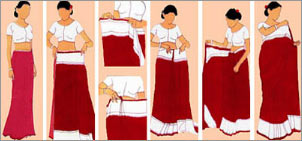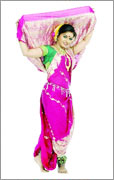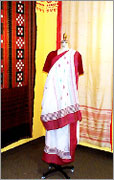How to Drape Saree in Different Ways
Saree can be draped in as many styles as there are types
of Indian sarees. The most common style of
draping a saree is the Nivi style which was originally common in the state
of Andhra Pradesh but now has become the most popular style of sari draping
all over India. Apart from the nivi style of draping saree, almost each
state has its own style of sari draping. Therefore,
Indian sarees by region
can also be categorized according to their wearing styles. Before moving on
to know the different styles of wearing a saree, it is good to know the
traditional sari draping technique.

 Most
of the sarees including the
sarees of west India
are six yard long. However, one of the western states of Inia- Maharashtra-
has a special saree called 'Maharashtrian Nauvari Sari' is nine yards in
length. It is draped without a petticoat.
Most
of the sarees including the
sarees of west India
are six yard long. However, one of the western states of Inia- Maharashtra-
has a special saree called 'Maharashtrian Nauvari Sari' is nine yards in
length. It is draped without a petticoat.
 Most
of the sarees of East
India are handloomed sarees. The more traditional benagli handloomed
sarees are made in such a way that they look most graceful when worn in a
Bengali drape. Light weight cotton sarees with smaller borders also look
great in such style. There are much less pleats in this style (most of the
times, it is only two very wide pleats). Here is stepwise instruction about
draping sari the bengali style.
Most
of the sarees of East
India are handloomed sarees. The more traditional benagli handloomed
sarees are made in such a way that they look most graceful when worn in a
Bengali drape. Light weight cotton sarees with smaller borders also look
great in such style. There are much less pleats in this style (most of the
times, it is only two very wide pleats). Here is stepwise instruction about
draping sari the bengali style.

Nivi Style or Traditional Saree Draping
For wearing a saree get a matching petticoat and blouse. While the petticoat should be of the same color as saree, blouse can be of contrasting color also in order to give different effects to the saree.- Open the folds of the sari and hold its inner plain end (This end is least patterned as different from the other end which is the “pallu” or “aanchal” of the saree). Tuck this inner plain edge into the waistband of the Petticoat slightly to the right side.
- Wrap around and tuck in the rest of the saree from right to left. Ensure that the lower end of the sari touches the floor. Its better to wear your sandal before tying the saree so that right length of saree can be determined while tucking it in.
- Now take the “pallu” or the patterned end of the saree and measure it at about 1 to 1-1/2 meters. Take it behind yourself from your left and bring it in front of you again from your right. This will leave behind the middle portion of saree that can be pleated into the waistband.
- Fling the pallu over your left shoulder to keep it out of the way while you make the pleats of your saree.
- Take the loose end of the saree at the right side (where tucking in has been stopped) and with the help of your hand, start pleating the remaining saree into five to six inch wide pleats.
- Hold all the pleats together. Make sure that the bottom end is level with the rest of the Saree all round and tuck them into the waistband of the petticoat. Tuck the pleats into the waist slightly to the left of the navel, and make sure that they are turned towards the left.
- The Pallu of the Saree, lying on your left shoulder can also be arranged in two to three bigger pleats and pinned up with the blouse at the back of the left shoulder. Alternatively, the pallu can be left to cover whole of your left arm.
Gujarati or North Indian Style of Draping Saree
Sarees of North India which are mostly worn by the women of Gujarat, Rajasthan, Uttar Pradesh, Madhya Pradesh, and Bihar are draped in a slightly different way where the pally is kept in the front instead of leaving it at the back. The method of draping sari in Gujarati style is almost similar to the technique described above for draping saree in the traditional way except for the last step. Here the pallu which lies on the left shoulder during making of pleats, is brought forward from the back by draping it over the right shoulder. The left edge of pallu is tucked in at the extreme left side of the petticoat's waistband. The portion of the pallu which is left to hang behind appears in a J-shaped arc at the back.Maharashtrian Style of Draping Saree
 Most
of the sarees including the
sarees of west India
are six yard long. However, one of the western states of Inia- Maharashtra-
has a special saree called 'Maharashtrian Nauvari Sari' is nine yards in
length. It is draped without a petticoat.
Most
of the sarees including the
sarees of west India
are six yard long. However, one of the western states of Inia- Maharashtra-
has a special saree called 'Maharashtrian Nauvari Sari' is nine yards in
length. It is draped without a petticoat.
- Open the sari and hold it behind in a way that divides the saree in two parts- one of which is roughly a quarter of the sari and is to your right side. The rest of the saree is at the other side (left side).
- Tie a knot using a bit of sari from both the parts. The knot should be tight as it will serve as a petticoat.
- Now drape the longer part of the saree at the left side like a normal sari. One layer is wrapped around. Pallu is draped over the shoulder and pleats are tucked into the knotted part.
- Pleat the smaller portion of the saree at the right side which loosely hangs. Make the pleats less wider. Hold the pleats together and take in between the legs and tuck them at behind. This can also be secured with a pin.
- Cover the right shoulder with the pallu from behind.
Bengali Style of Draping Saree
 Most
of the sarees of East
India are handloomed sarees. The more traditional benagli handloomed
sarees are made in such a way that they look most graceful when worn in a
Bengali drape. Light weight cotton sarees with smaller borders also look
great in such style. There are much less pleats in this style (most of the
times, it is only two very wide pleats). Here is stepwise instruction about
draping sari the bengali style.
Most
of the sarees of East
India are handloomed sarees. The more traditional benagli handloomed
sarees are made in such a way that they look most graceful when worn in a
Bengali drape. Light weight cotton sarees with smaller borders also look
great in such style. There are much less pleats in this style (most of the
times, it is only two very wide pleats). Here is stepwise instruction about
draping sari the bengali style.
- Open the saree and wrap it around yourself from right to left and tuck it in the petticoat's waistband.
- Keep wrapping around the body back to the right hip and make a fold for the first pleat, reverse the saree and draw it back over to your left hip, then again reverse the fabric and draw it back to your right hip. This way you get two large pleats in the front.
- Hold the pleats up, level them with the first wrap of sari underneath and tuck neatly into the waistline.
- Take the top border of the sari and keep it on your left shoulder. Grasp the top border midway between the waist and shoulder and pull the sari out in front of you. Pull it until there is enough length to wrap around to your mid back.
- Tuck it into the waist in the middle of the back.
- Bring the pallu (which is draping at the back from over the left shoulder) from under the right hand and again drape it over the left shoulder in such a way that the bottom end remains below the waistline. This will leave only a very small portion of pallu at the back which should be supported by something slightly heavier, like keys, to keep it at the back.